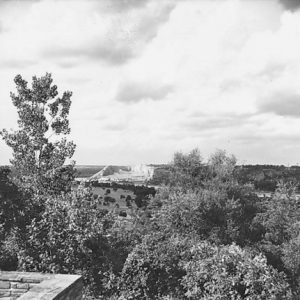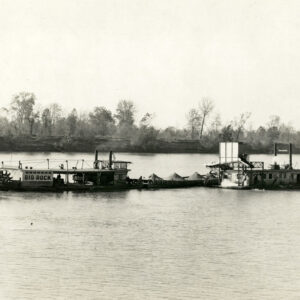calsfoundation@cals.org
Crushed Stone Mining
Crushed stone is an angular form of construction aggregate, made by breaking quarried rock into fragments that may be sorted, sized, and recombined into a variety of products. Crushed stone is typically quarried—that is, mined using benching methods (carrying out work from a ledge in a mine or quarry) and explosives, as opposed to the mechanical digging used for extracting sand and gravel. Consolidated rock is cut into vertical ledges, so that drilling can be done from above to place explosives within the wall for proper breakage of rock during mining. Benches typically vary from twenty to sixty feet in height, depending on how competent the rock is. The quarry stone is normally run through a primary crusher and then through secondary crushers to produce angular fragments in a variety of sizes. The angularity of the product results a high surface area, giving any given binder, like cement or asphalt, more surface area for adhering. This increases the strength of the final product. Crushed stone finds uses as aggregate in concrete and macadam for road construction; concrete for foundation and building construction; and for non-binder uses, such as river bank riprap, railroad track ballast, and filter stone. Fines, principally dust-sized particles produced by the crushing process, may be used in a variety of applications, such as plastic fillers, compaction fill materials, ceramic and brick frits, and even herbicide and/or pesticide carriers. One specialty crushed stone application includes roofing granules.
Crushed stone is a high-volume, low-unit-cost material. Transportation is a critical cost in its competitiveness across a given area. Therefore, no matter how cheaply it may be produced and sold at the quarry, the distance to a job site determines the economic feasibility of any given quarry stone being used at any given site. This explains the necessity of multiple quarry operations across any region. Various engineering tests are performed on quarry stone being considered for concrete and macadam applications to determine if the stone can remain competent through the extremes of weathering and exposure.
To produce crushed stone, a company must locate deposits within an area that contains geologic formations that meet the specifications required by its principal uses. In Arkansas, the harder rock formations are confined to the region of the state whose formations were deposited during the Paleozoic era, including the Ouachita Mountains, Arkansas Valley, and Ozark Plateau geographic regions. The Gulf Coastal Plain and Mississippi River Valley regions of Arkansas contain little hard stone suitable for quarrying. Several types of rock have been quarried and crushed in Arkansas, including Arkansas novaculite, sandstone, limestone, dolostone, nepheline syenite, and tuff.
Arkansas novaculite is a hard, brittle, silica-rich stone that at one time was used within central Arkansas as an aggregate for concrete and macadam roads. However, besides being extremely abrasive to mining and crushing equipment, novaculite also had an impermeable nature and broke in such a way that asphalt and cement did not adhere well to the stone. As the binder wore off, the exposed aggregate produced a road surface that was slick when wet, an unacceptable condition for modern high-speed transportation. As of 2009, there is only one active aggregate producer crushing novaculite.
Sandstone is widely distributed within the Ouachita Mountains, Arkansas Valley, and Boston Mountains sub-region of the Ozarks and is a commonly used stone for aggregate. Sandstone is a sedimentary rock that is composed of rounded to angular sand-sized particles of quartz and may contain admixed variable amounts of clay, feldspar, and rock fragments. The quality of any given sandstone depends on its degree of cementation, the actual cement, and its mineral content. Friable or poorly cemented sandstone is not used. Geologic formations in the Ouachita Mountains quarried for sandstone include the Crystal Mountain, Blakely, Stanley, Jackfork, and Atoka formations. In the Arkansas Valley, sandstones within the Savanna, Hartshorne Sandstone, Atoka, and Hale formations are quarried and crushed. In the Ozarks region, the lower Atoka, Bloyd, Hale, Batesville, St. Peter, and Everton formation sandstones are the principal units. Louisiana, Mississippi, and Texas have been areas of major markets for high-quality Arkansas crushed sandstone. In 2005, eighteen quarries produced 10.8 million metric tons of crushed sandstone and quartzite, valued at $69.5 million.
Limestone and dolostone are sedimentary rocks consisting predominantly of carbonate minerals and are widespread in the Ozark region of Arkansas. The Cotter, Powell, Everton, Plattin, Kimmswick, Fernvale, St. Clair, Boone, and Pitkin formations are the principal formations that are quarried and crushed. The bulk of the crushed material is used in road construction and concrete aggregate. In 2005, one dolostone and twenty-eight limestone quarries were active, with total production of 15.2 million short tons, valued at $92.4 million.
Nepheline syenite is an igneous rock that crops out in central Arkansas. It was emplaced in the shallow crust during the Cretaceous era (about 100 million years ago) and is now exposed due to erosion. Nepheline syenite has superior strength characteristics and is relatively easy to crush, being internally uniform due to its mineralogical composition and crystalline texture. It differs from granite in that it contains no free quartz grains and is therefore less abrasive to equipment. Two companies in central Arkansas operate four quarries—three in Pulaski County and one in Saline County. The company Granite Mountain Quarries, operated by McGeorge Construction Company, operates three aggregate quarries, and Minnesota Mining and Manufacturing Company, Inc., produces roofing granules and confined construction fill from its Big Rock quarry. Production of syenite for aggregate averages over 5.5 million metric tons annually, while production of syenite for roofing granule feed amounts to over 1 million tons per year. End production of roofing granules is approximately 450,000 tons annually.
Slatey shale and metamorphosed shale are produced from two mines, one each in Montgomery and Hot Spring counties. Both operations are sited in the Stanley Shale. Production of slatey shale from Montgomery County finds end use as black roofing granules, whereas the metamorphosed shale adjacent to Magnet Cove (Hot Spring County) is used for concrete and asphalt aggregate.
Tuff is a pyroclastic igneous rock composed of volcanic ash and fragmented pumice, formed when accumulations of the debris are cemented together. Accumulations of tuff are present as distinct stratigraphic horizons within the Stanley Shale of the Ouachita Mountains region of Arkansas. At one location in western Arkansas, near the community of Hatton (Polk County), the tuff has been mined for crushed stone. In 2008, the company halted mining of tuff and began quarrying the Arkansas novaculite. Production from individual companies is held confidential by the U.S. Geological Survey, so no production figures have been made available. Tuff was used for railroad track ballast, shoulder top dressing, and concrete aggregate.
Total production of crushed stone construction aggregate from all sources for 2005 was 37.2 million metric tons, valued at $229 million, up significantly in recent years.
For additional information:
Arkansas State Minerals Information. U.S. Geological Survey. http://minerals.usgs.gov/minerals/pubs/state/ar.html (accessed March 14, 2022).
“Industrial Minerals.” Arkansas Geological Survey. https://www.geology.arkansas.gov/minerals/industrial.html (accessed March 14, 2022).
Stroud, R. B., R. H. Ardnt, F. B. Fulkerson, and W. G. Diamond. Mineral Resources and Industries of Arkansas. U.S. Bureau of Mines Bulletin 645. Washington DC: U.S. Bureau of Mines, 1969.
J. Michael Howard
Mabelvale, Arkansas
 Business, Commerce, and Industry
Business, Commerce, and Industry Big Rock Quarry
Big Rock Quarry  Big Rock Quarry
Big Rock Quarry 




Comments
No comments on this entry yet.